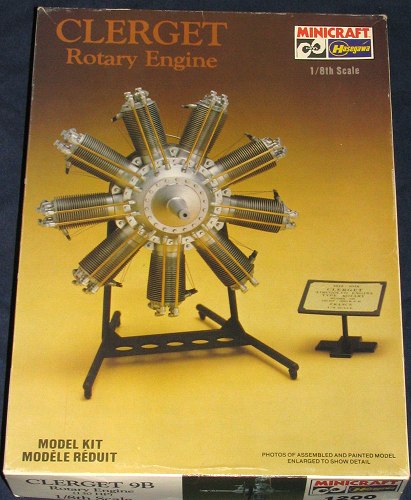
| KIT: | Hasegawa 1/8 Clerget 9B Rotary Engine |
| KIT #: | 1200 |
| PRICE: | $ |
| DECALS: | None |
| REVIEWER: | Scott Van Aken |
| NOTES: | Minicraft Boxing (which means you can read the instructions). |

| HISTORY |
The Clerget rotary engine was one of the best produced during WWI and powered many Allied aircraft, including the Sopwith Camel and the Avro 504. It is not generally realized that in those days, the cost of the engine was usually more than that of the airframe. As an example, the Sopwith Camel airframe had an MSRP of £874 10s. The Clerget engine that powered it cost £907 10s. This is somewhat typical of aircraft up to the Second World War. Nowadays, with some military aircraft, it is the cost of avionics that is the the greatest!
The Clerget had neither the peculiar intake arrangements of the Gnome nor the strange connecting rods of the Le Rhone. Its valves were actuated by conventional rocker arms from two pushrods per cylinder, these constituting a recognition feature. Clergets were made in 110-hp and 130-hp models, and the 130 may have been a little overdeveloped, since it was subject to overheating. It used a special type of piston ring, called an "obdurator" ring, below the wrist pin to block heat transfer from the combustion area to the lower part of the cylinder. When this ring broke, as it was prone to do, the cylinder turned blue from the heat; a blue color meant that the steel had been heated to 600°F (316°C). Clergets were generally very well engineered except for this problem, those made in England by Gwynne being especially excellent.
| THE KIT |
 Now I fully realize that there are not
many kits out there in 1/8 scale that can take this engine. I do believe
that this was originally from the highly expensive Hasegawa 1/8 Sopwith
Camel. However, the engine itself makes for a very nice model. There are
six sprues in either light grey or black; three of these sprues being
identical as they are for the engine cylinders and the accompanying
hardware. The stand is in black plastic and the pushrods for the valves are
brass rod.
Now I fully realize that there are not
many kits out there in 1/8 scale that can take this engine. I do believe
that this was originally from the highly expensive Hasegawa 1/8 Sopwith
Camel. However, the engine itself makes for a very nice model. There are
six sprues in either light grey or black; three of these sprues being
identical as they are for the engine cylinders and the accompanying
hardware. The stand is in black plastic and the pushrods for the valves are
brass rod.
The kit parts are very well molded with no flash or sink areas. There are some ejector pin marks, most of which will be hidden. Probably the most difficult to remove, and even those won't be that tough, are on the sides of the rocker arms. There are no optional parts or clear pieces with this one. Instructions are well done with 8 well drawn construction steps. A written sequence is provided as well. Painting instructions are provided in generic terms where needed, though you can glean a lot of information in this regard from the buildup on the box top. A diagram for wiring the spark plugs is provided and recommends using thread. Personally, I'd use brass wire, but thread is probably the easiest. There are no decals but a sticker (not shown) is provided for the information stand that is part of the kit.
| CONCLUSIONS |
Though this is not everyone's cup of tea, it does have a lot of detail and can be easily made into a very nice model. Perfect for those whose passion is WWI aircraft or those who like to build models of power plants.
Review kit courtesy of me and my scrounging at swap meets.
If you would like your product reviewed fairly and quickly by a site that has nearly 300,000 visitors a month, please contact me or see other details in the Note to Contributors.